"If I forget thee, O Jerusalem, let my right hand forget her cunning (skill)."
If I do not remember thee, let my tongue cleave to the roof of my mouth; if I prefer not Jerusalem above my chief joy."
(Psalm 137:5-6)
If I Forget Thee
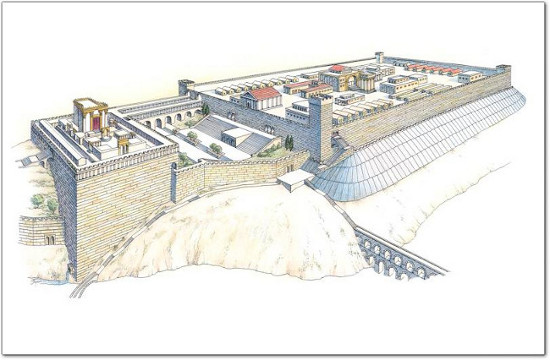
Dear Friends,
Greetings. On March 11, this year, 2013, we posted an article titled, "Holy Hill Of Zion", concerning a book by Dr. Ernest L. Martin, "The Temples that Jerusalem Forgot."
Since posting that article we have spent a considerable amount of time reading Ernest Martin's 476 page book. Along with personally checking the majority of his 704 cross references, we have come to the conclusion that he is absolutely correct in his summation that the original Temple of Solomon, Herod, and others was not situated inside the Haram esh-Sharif (Haram Al-Sharif), where the Dome of the Rock is located, but over the Gihon Spring south of the Haram esh-Sharif.
Why this is important is because it could have a profound effect concerning End Time Bible prophecy. The Bible speaks of the rebuilt Jewish Temple in Jerusalem, being the place from where the antichrist will proclaim that he is God, three and one-half years before Jesus returns to set up His one thousand year reign on earth, to usher in an age of righteousness.
"For the earth shall be filled with the knowledge of the glory of the LORD, as the waters cover the sea." Habakkuk 2:14
The most contentious piece of real estate on earth, with no exaggeration, is the Dome of the Rock, which is holy to both the Jews and the Muslims.
The Jews believe their long awaited Messiah cannot arrive to redeem them until they have built their Temple. They believe, erroneously, that it is situated where the Mosque of Omar now stands.
If this is not the case, and they, the Temples, were located at the Gihon Spring, and they are able to believe it, receive it, and act upon it, it would make a phenomenal difference in the past, present, and definitely the future.
Here are the verses in the Bible that tell the exact location of where Solomon's Temple was built.
2Samuel 24:18-25 "And Gad came that day to David, and said unto him, Go up, rear an altar unto the LORD in the threshingfloor of Arau'nah the Jeb'usite. And David, according to the saying of Gad, went up as the LORD commanded. And Arau'nah looked, and saw the king and his servants coming on toward him: and Arau'nah went out, and bowed himself before the king on his face upon the ground.
And Arau'nah said, Wherefore is my lord the king come to his servant? And David said, To buy the threshingfloor of thee, to build an altar unto the LORD, that the plague may be stayed from the people. And Arau'nah said unto David, Let my lord the king take and offer up what seemeth good unto him: behold, here be oxen for burnt sacrifice, and threshing instruments and other instruments of the oxen for wood. All these things did Arau'nah, as a king, give unto the king. And Arau'nah said unto the king, The LORD thy God accept thee. And the king said unto Arau'nah, Nay; but I will surely buy it of thee at a price: neither will I offer burnt offerings unto the LORD my God of that which doth cost me nothing.
So David bought the threshingfloor and the oxen for fifty shekels of silver. And David built there an altar unto the LORD, and offered burnt offerings and peace offerings. So the LORD was entreated for the land, and the plague was stayed from Israel."
2Chronicles3:1 "Then Solomon began to build the house of the LORD at Jerusalem in mount Mori'ah, where the LORD appeared unto David his father, in the place that David had prepared in the threshingfloor of Ornan the Jeb'usite."
Below are some photos showing the interior of the Mosque of Omar, the Rock, and a threshing floor.

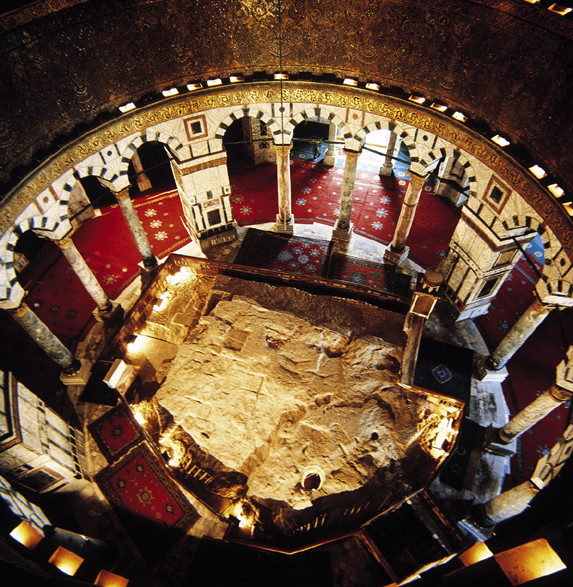
The Rock from a top view.
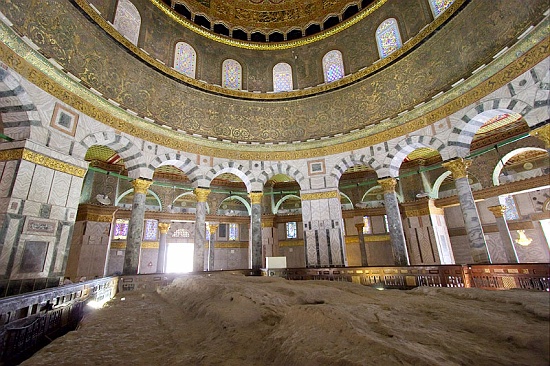
The Rock from a side view.
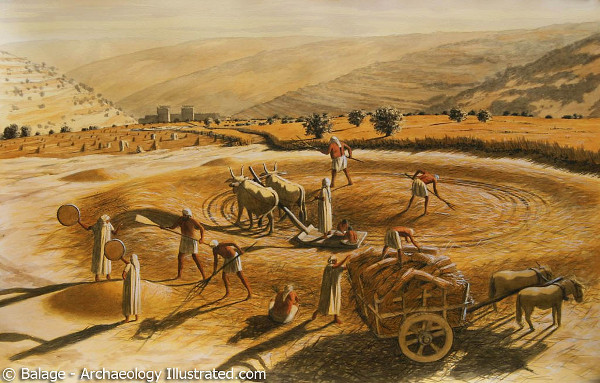
A threshing floor.
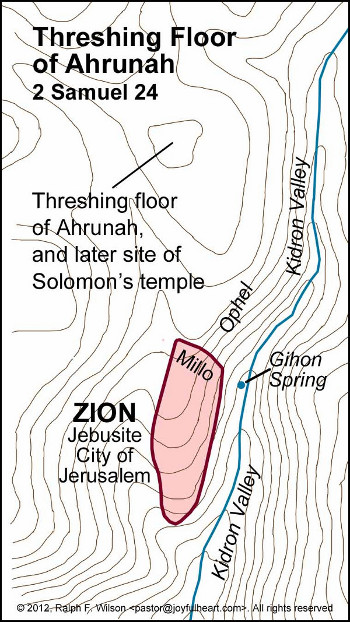
As you can see from the photos, the top of the Rock could never serve as a threshing floor.
We have included a link to a very abridged version of Dr. Martins, "The Temples that Jerusalem Forgot."
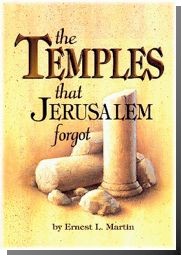
You may find the following verses of interest, several of them come from the Book of Nehemiah, which deals with the the rebuilding of what is known as Zerubbabel's Temple.
The books of Nehemiah and Ezra take place (586 B. C. ?) at the time Cyrus, king of Persia gave certain Jews, including Zerubbabel, Ezra, and Nehemiah permission to return to Jerusalem and begin the rebuilding of the Temple in Jerusalem.
"Thus saith Cyrus king of Persia, The Lord God of heaven hath given me all the kingdoms of the earth; and he hath charged me to build him an house at Jerusalem, which is in Judah.
Who is there among you of all his people? his God be with him, and let him go up to Jerusalem, which is in Judah, and build the house of the Lord God of Israel, (he is the God,) which is in Jerusalem." Ezra 1:2-3
Here are some interesting verses out of the book of Nehemiah that show the rebuilding of the Temple. Note the words that are highlighted.
2:15 "Then went I up in the night by the brook, and viewed the wall, and turned back, and entered by the gate of the valley, and so returned.
3:7 And next unto them repaired Melati'ah the Gib'e-onite, and Jadon the Meron'othite, the men of Gibeon, and of Mizpah, unto the throne of the governor on this side the river.
3:15 But the gate of the fountain repaired Shallun the son of Col - ho'zeh, the ruler of part of Mizpah; he built it, and covered it, and set up the doors thereof, the locks thereof, and the bars thereof, and the wall of the pool of Silo'ah by the king's garden, and unto the stairs that go down from the city of David.
3:16 After him repaired Nehemi'ah the son of Azbuk, the ruler of the half part of Beth - zur, unto the place over against the sepulchres of David, and to the pool that was made, and unto the house of the mighty.
3:26 Moreover the Neth'inim dwelt in Ophel, unto the place over against the water gate toward the east, and the tower that lieth out.
3:27 After them the Teko'ites repaired another piece, over against the great tower that lieth out, even unto the wall of Ophel.
12:37 And at the fountain gate, which was over against them, they went up by the stairs of the city of David, at the going up of the wall, above the house of David, even unto the water gate eastward."
As noted in "The Temples that Jerusalem Forgot." the only fresh running water within five miles of Jerusalem is the Gihon Spring.
2 Chronicles 32:30 "This same Hezeki'ah also stopped the upper watercourse of Gihon, and brought it straight down to the west side of the city of David. And Hezeki'ah prospered in all his works."
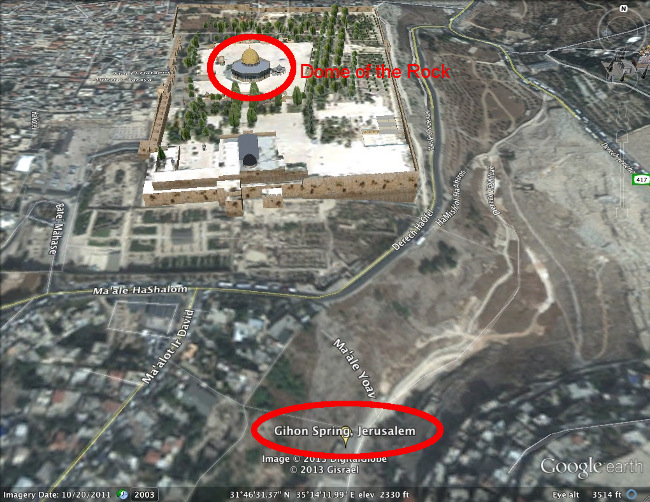
Gihon Spring in relationship to the Dome of the Rock
So, the big question is, when will the Temple be rebuilt. The quote below may give some indication:
The Christian historian Sozomen went father in his description of the Temple Mount in Julian's time. He said the Jews found the "ruins of the former building [the Temple built in the time of Constantine], they dug up the ground and cleared away its foundation [of the recent Temple]; it is said that the following day when they were about to lay the first foundation [of their new Temple], a great earthquake occurred, and by the violent agitation of the earth, stones were thrown up from the depths, by which those of the Jews who were engaged in the work were wounded, as likewise those who were merely looking on. The houses and public porticos near the site of the Temple [the Jews found buildings and colonnades already located on the Temple Mount - also built in the time of Constantine]; in which they [the Jews] had diverted themselves, were suddenly thrown down." 277
277 Sozomen, History V.22.
In God's time..... and it would appear to be getting very close.
"For I would not, brethren, that ye should be ignorant of this mystery, lest ye should be wise in your own conceits; that blindness in part is happened to Israel, until the fulness of the Gentiles be come in. " Romans 11:25
How the “rock” under the Dome of the Rock came to be believed to be the location of Solomon's Temple
The Muslim account of the fourteenth century titled Muthir al-Ghiram summarizes early events at the beginnings of Islam by stating that Omar, the Second Caliph [the second successor to Muhammad], came to Jerusalem in 638 C.E. Seeking to pray at the place where King David erected the altar that became the site of the Temple. This historical record states that Omar had been given a divine revelation from God (so this account relates) wherein the prophet Muhammad showed him the area from whence Muhammad ascended from the “Farthest Masque” and into heaven. The Christian authority in charge of Jerusalem at this period was Sophronius, the patriarch of the Church of the Holy Sepulcher, was summed to a conference by Omar.
Sophronius was well aware of the spot the Jews had claimed for their Temple site, but since the time of Hadrian the area had been turned in the city dump (and was reconfirmed as a dump in the time of Constantine).
The area for all practical purposes was vacant and was a place where people of Jerusalem cast their refuse.
Sophronius then took Omar and his associates to the place where the Jews believed the Temple site was. The spot was just above and near the Gihon Spring. [Then] Sophronius pointed out to Omar ...the place where David prayed. [There was a rock]a portable stone. It was not a permanent outcropping of rock like under the Dome of the Rock.
The “rock” in Eutychius” account was actually a “stone” that could be carried by humans. Omar even took that particular “rock” and carried to into the region of the Haram esh-Sharif. He then made this portable “rock” part of his qibla area in what was to become known as the Al Aqse Mosque.
(Later Jewish records state that an elderly Jewish man helped Omar discover a stone underneath the refuse that represented where the Holy of Holies once stood.)
[The stones] were from the previous Temple begun at the time of Julian the Apostate (362 C.E.)
The “Stone” Was Transferred to the Haram esh-Sharif
With the discovery of the “stone”
from what Omar thought was the site of Solomon's Temple, he looked
around that part of Jerusalem for the place to build his shrine or
mosque as he had been told to do in his vision. Omar then looked
north at the southern wall of the Haram esh-Sharif where he saw a
gate allowing entrance into the enclosure. This southern gate was
particularly important to Omar because of a prime teaching of Islam
that was beginning to circulate at this period.
It concerned an account of Muhammad's vision of a Night Journey on his fabled horse named Buraq. A cardinal factor of the story was a southern gate through which Muhammad was supposed to have entered an enclosure from whence he went to heaven. Omar thought that this southern gate of the Haram might be the one associated with the Night Journey of the Prophet.
Omar and Sophronius took the “stone” from the Jewish Temple site south of the Haram and with the
other Muslims went through the southern gate in the Haram. Omar looked at the geographical factors of the spot and came to the conclusion that this was the region shown in his vision associated with Muhammad's Night Journey. It was the spot he wanted to build his Mosque.
Omar then named the southern gate of the Haram the Bab al-Nabi (the Gate of the Prophet) in dedication to the holy event of the site as Omar judged it, he then placed the “stone” from the southern Temple Mount to this southern part of the Haram esh-Sharif. He put it at the southern end of the building and it became a part of the qibla that pointed toward Mecca. This was the place that finally became the Al Aqse Mosque.
This moving of the “stone” to the inside southern wall of the Haram (along with many other rectangular stones used for building purposes) answered to an official relocating of the holiness of Solomon's Temple from its former spot over the Gihon Spring to this new site about 800 feet north. That is why it became common after the time of Omar by most people in Jerusalem to view the Al Aqsa Mosque as the pace of “Solomon's Temple.”
During the Crusades, the Christians finally had enough historical sense to abandon their belief that the Church of the Holy Sepulcher had had been part of Herod's Temple. They then joined the Muslims and took it for granted that the building the Al Aqse Mosque was the place where Solomon's Temple once stood.
The Abbasid Dynasty
The importance of the “Rock” under the Dome of the Rock changed dramatically and swiftly with the Abbasid Dynasty beginning in 750 C.E. Not only the footprints of Jesus (and even God's) were believed to on the “Rock” but Muhammad's footprints (and also his handprint) were discovered near 750 C.E. These new “facts” proved to many Muslims that Muhammad's famous Night Journey to heaven took place on the “Rock,” and not at the Al Aqsa Mosque. From then on, a flood of folklore traditions descended upon the “Rock” that caused the Muslims to transfer almost all the events associated with the former Jewish Temple to the “Rock,”. It has remained that way ever since. Taken from “The Temples that Jerusalem Forgot” by Ernest L. Martin pages 114-134.
One issue that is not dealt with in Dr. Martins book, is the subject of the Ark of the Covenent.
In chapter three of his book, Jeremiah said:
"And it shall come to pass, when ye be multiplied and increased in the land, in those days, saith the Lord, they shall say no more, The ark of the covenant of the Lord: neither shall it come to mind: neither shall they remember it; neither shall they visit it; neither shall that be done any more." Jeremiah 3:16
What happened to the Ark of the Covenant after the complete destruction of the Temple by Nebuchadnezzar and his armies in 586 BC. If 2 Maccabees is correct, it is in a cave on Mount Nebo.
The book of 2 Maccabees, in "The Apocrypha" may hold the answer.
"The general term (Apocrypha) is usually applied to the books in the Roman Catholic Bible or the Christian Old Testament, and the Eastern Orthodox Bible, but not the Protestant Bible. In Luther's Bible of 1534 the Apocrypha was first published as a separate intertestamental section. Luther was making a polemical point about the canonicity of these books. As an authority for this division, he cited St. Jerome, who in the early 5th century distinguished the Hebrew and Greek Old Testaments, stating that books not found in the Hebrew were not received as canonical. Although his statement was controversial in his day, Jerome was later titled a Doctor of the Church and his authority was also cited in the Anglican statement in 1571 of the Thirty-Nine Articles.
There was agreement among the Reformers that "The Apocrypha" contained "books proceeding from godly men" and therefore recommended reading. The Geneva Bible said this in 1560." (Wikipedia)
"It was also contained in the same writing, that the prophet, being warned of God, commanded the tabernacle and the ark to go with him, as he went forth into the mountain, where Moses climbed up, and saw the heritage of God. "And when Jeremy came thither, he found an hollow cave, wherein he laid the tabernacle, and the ark, and the altar of incense, and so stopped the door. And some of those that followed him came to mark the way, but they could not find it. Which when Jeremy perceived, he blamed them, saying, As for that place, it shall be unknown until the time that God gather his people again together, and receive them unto mercy.
Then shall the Lord shew them these things, and the glory of the Lord shall appear, and the cloud also, as it was shewed under Moses, and as when Solomon desired that the place might be honourably sanctified." 2 Maccabees 2:4-8
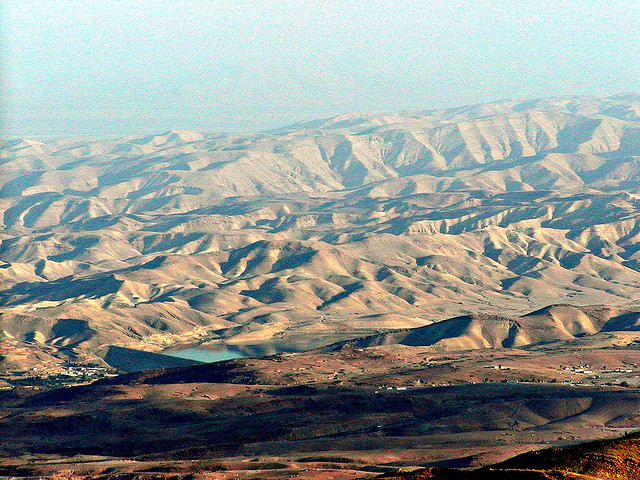
Mount Nebo
If this is true, the Ark of the Covenant, the very center of Jewish worship for remission of sin, has not been available to the Jews since around the time of the Babylon destruction of the Temple in approximately 586 B.C.
"And Moses went up from the plains of Moab unto the mountain of Nebo, to the top of Pisgah, that is over against Jericho. And the Lord shewed him all the land of Gilead, unto Dan, And all Naphtali, and the land of Ephraim, and Manasseh, and all the land of Judah, unto the utmost sea, And the south, and the plain of the valley of Jericho, the city of palm trees, unto Zoar.
And the Lord said unto him, This is the land which I sware unto Abraham, unto Isaac, and unto Jacob, saying, I will give it unto thy seed: I have caused thee to see it with thine eyes, but thou shalt not go over thither.
So Moses the servant of the Lord died there in the land of Moab, according to the word of the Lord. And he buried him in a valley in the land of Moab, over against Bethpeor: but no man knoweth of his sepulchre unto this day." Deuteronomy 34:1-6
This brings up a question, why did Jesus say in the Gospel of John, chapter two, verse sixteen; " And (He)said unto them that sold doves, Take these things hence; make not my Father's house an house of merchandise." If there was no Ark, no Shekinah Glory, how could He still have called the Temple His "Fathers house".
“(Shekinah, (Hebrew: שכינה) is the English spelling of a grammatically feminine Hebrew ancient blessing of God. The original word means the dwelling or settling, and denotes the dwelling or settling of the divine presence of God, especially in the Temple in Jerusalem.
In Biblical Hebrew that Semitic root means literally to settle, inhabit, or dwell, and is used frequently in the Hebrew Bible. See Exodus 40:35, "Moses could not enter the Tent of Meeting, for the cloud rested [shakhan] upon it, and the glory of the Lord filled the Tabernacle.") Wikipedia

“O
Lord of hosts, God of Israel, that dwellest between the cherubims,
thou art the God, even thou alone, of all the kingdoms of the earth:
thou hast made heaven and earth.”
Isaiah
37:16
The answer may be found in the book of Micah, chapter four, verse ten: "Be in pain, and labour to bring forth, O daughter of Zion, like a woman in travail: for now shalt thou go forth out of the city, and thou shalt dwell in the field, and thou shalt go even to Babylon; there shalt thou be delivered; there the Lord shall redeem thee from the hand of thine enemies."
God dwells in Zion, His people, and His presence can move.
"But thou art holy, O thou that inhabitest the praises of Israel." Psalm 22:3
"Know ye not that ye are the temple of God, and that the Spirit of God dwelleth in you?" 1 Corinthians 3:16
Appendment:
Today the Brook Kidron flows very intermittently toward the Dead Sea, but “Something remarkable happened to that natural spring. It was a most important event that had a profound effect upon the Jewish population at Jerusalem and the need for their presence in the Holy City. In the year 1067 C.E., another major earthquake hit Jerusalem. It was so devastating that the records show 25,000 people died in Jerusalem alone, and only two houses remained standing in the Jewish quarter of the city on the southeast side.191 A few years before this time, the Gihon Spring was referred to as having good waters, but after 1067 C.E., the waters of the Gihon Spring turned bitter and unpalatable for normal drinking. All historical works (including Greek, Roman, Jewish and Muslim) show evidence that demonstrate the freshness of the Gihon Spring waters prior to this date. Indeed those waters from time immemorial had been fresh waters that were the envy of all. So pure were they that they symbolically came to represent the “waters of salvation” that issued from the throne of God in the Temple (mentioned many times in the Scriptures).All of a sudden those “holy waters” became brackish and unsuitable for normal drinking. The earthquake may have moved underground strata introducing impurities into the water, or seepage from the city sewage areas. The change from fresh pure water to a brackish and tarnished state had a mystical and prophetic significance to the Jewish people of Jerusalem. The original “Mount Zion: had become polluted, and it reminded them of the same type of description in the prophecies of Jeremiah that also occurred at the time of Nebuchadnezzar. “The Temples that Jerusalem Forgot” pages 150-151:
191The waters of the Gihon turned bitter at least once in the time of Jeremiah. The prophet told the Jews of his time that God sat on “a glorious high throne from the beginning in the place of our sanctuary [which had a fountain of living waters but] they have forsaken the fountain of living waters” (Jeremiah 17:12-13).
This condition happened just before the destruction of the Temple in the time of Jeremiah. Later, the Gihon Spring that came from the throne of God withing the Temple precincts again became fresh and clean.”
Thought to ponder
If the Temple requires a fresh water source, and the Gihon is no longer a fresh water source, this then presents somewhat of a conundrum.
Could it be that the powers behind the rebuilding of the Temple are aware of the above, and this is why they will not accept the evidence for where the Temple should be built and continue to hold on to the Dome of the Rock as its original site.
Or will the Gihon need to become fresh and clean again before the building of the Temple. Or will the Temple be built within the Haram Al-Sharif and later be moved south to the vicinity of the Gihon Spring possibly when Jesus returns and the Mt. of Olives is split in half, with half of it moving toward the north and half of it moving toward the south. Or does the Lord have something entirely different in mind. Zechariah 14:4
“O the depth of the riches both of the wisdom and knowledge of God! how unsearchable are his judgments, and his ways past finding out! For who hath known the mind of the Lord? or who hath been his counsellor?” (Romans 11;34-35)
Have a great week ahead.
+++
WND EXCLUSIVE
DID JEWISH TEMPLE ACTUALLY SIT ON 'TEMPLE MOUNT'?
New documentary makes case that history, tradition got it wrong
Published: 03/20/2013
There is no more highly anticipated event in the history of mankind than the return of Christ to the earth; all the maladies that beset the human race will disappear. Over the centuries there have been numerous signs that have pointed the world toward the magnificent and concluding event.
But there is a last sign, and the implications are monumental to every human being on the face of the planet. "Jerusalem and the Lost Temple of the Jews" is about that last sign.
From Ken Klein, the author of the best-selling book "America Globalism and the False Prophet," comes the new documentary film "Jerusalem and the Lost Temple of the Jews." Klein shows Jerusalem was actually a modern Roman city in the first century and how the discovery of Hezekiah's tunnel changed everything. Hear the five survivors from the Masada massacre tell their incredible story.
The premise of this breakthrough film is that the prophesied and venerated Jewish temple does not belong, as all the world believes, on the "Temple Mount." For centuries the Jews have prayed at the "wailing wall" believing religious tradition, which places their temple where the Muslim Dome of the Rock defiantly sits. Is this really the actual site for their temple? Could the Jews be mistaken? Is their confusion concerning the site of their temple preventing the return of Christ?
Defying religious tradition, and as incredulous as it seems, "Jerusalem and the Lost Temple of the Jews" brings new and conclusive proof and undeniable evidence as to the proper and historical location of all the temples and why Christians, Jews, Muslims and historians all have it wrong.